It is one of the rarest and most expensive cartridges in existence. Prices of up to 2000$ have been paid for this item, asking prices were even higher. Estimates are that only 67 carts have been made, and how many of those still exist is in the dark. It is not only a collectible as a game itself, but also as a part of gaming history – at least in the U.S. For this reason, this isn’t going to be your regular kind of article. When talking about Blockbuster Video World Game Championship II, one has to understand where this item comes from, its peculiarity and the story behind that.
Let’s face it: When there’s gaming, there’s also competition. It’s always been that way! One of the very first video games, Pong, was all about being better than your opponent. Single-player games have always been about getting the highest score, aiming to be better than any other (at least on that particular machine). Even if a title is not primarily competitive in nature, like RPGs or adventure games, players have always found ways to turn them into a competition as well, as countless speed or achievement run videos have shown.
When it comes down to a single title, or even a genre of games, it isn’t hard to determine who is the better player. For example, you can easily pit gamers against one another in a series of fighting games by having a knockout tournament until only one competitor has remained undefeated. But that only proves that someone is the best in that particular breed of video games. But just because someone is a good fighter doesn’t also mean that he is good at sports games. Someone who reigns supreme in basketball isn’t automatically apt in soccer as well. And even if someone manages to get a perfect score at Pac-Man, he might just as well completely suck in Sonic 2 when compared to a 10-year-old. Finding out who’s the best overall gamer, or the best at playing games on a specific console, is surprisingly hard. It’s even tougher to figure out a fair and representative method doing so. Some games have vs. modes, and others don’t. A direct K.O. mode isn’t always feasible, and in league modes the number of individual matches that need to be played increases exponentially with every player that competes. If you’ve followed our previous coverage of European, German and Portuguese Mega Drive tournaments here on Sega-16, you may have some idea of how hard it is to find the “right” way of handling such a tournament – and those are fan events starring a console 20 years after her prime, with a much smaller target audience.
Aside from those more recent examples born out of fandom, official cross-genre video game championships have been around basically since gaming existed. There was, of course, Atari’s legendary Swordquest event, brought to an abrupt end through the video game crash of 1983. Here, four games were specifically created for the intention of finding the best gamer there is (although only three ever actually saw release). Another well-known example was the Nintendo World Championships of 1990 (and, to a lesser degree, the Nintendo Campus Challenge and Nintendo PowerFest ’94), where the participants competed in specially modified versions of well known NES (later SNES) games. While the individual titles used in these Nintendo tournaments were generally well-known and widespread, the cartridges holding the modified versions have to this day become very rare and valuable for collectors.
Another of these big video game tournaments has, when compared to these other events, fallen into relative obscurity. In return, it has also led to one of the most sought after collectible game cartridges in existence. These were the Blockbuster Video World Game Championships (Interestingly enough, the first event was advertised as “Blockbuster Video World Game Championship,” while ads for the second read “Blockbuster World Video Game Championship II.” In 1993, Blockbuster was huge, and after merging with the media conglomerate Viacom, it appeared to be a major player in the American entertainment industry. This would come crashing down only a few years later, but before that happened, the new media giant established two series of video game tournaments. The first of those two was actually advertised like a world championship. Since Blockbuster owned outlets in several countries, ads printed in GamePro magazine proclaimed that the event was “open to legal residents of the United States and its territories, Canada, Australia, Chile and the United Kingdom.” Effectively though, only stores in the U.S. took part in the event.
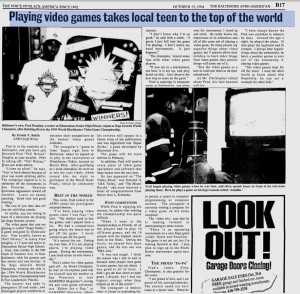 Here’s how the tournament worked: Each contestant would register in one of the many participating Blockbuster Video outlets. There, he would compete for the title of store champion, who would get two free rentals a month for the next two years. In the first tournament, this contest was held over three weeks in three different games. For the Genesis, these three games were NBA Jam, Sonic 3 and a then brand-new Virtua Racing. Each of those games was played in single-player mode, and some sort of high score was calculated. The store champions would move on to the state finals, and from there the state winner would compete in the finals held in Ft. Lauderdale that took place from August 19th-21st, 1994. The Genesis champion was Fred Doughty from Baltimore, while the Super Nintendo champion was Mark Guinane. The such proclaimed “world champions” would earn a day trip to the GamePro offices where they were allowed to be guest editors for a day (if anyone still has old issues of GamePro magazine, look for their take on Super Punch-Out). They were also promised to be digitized and placed into the next entry in EA’s Strike series (probably Urban Strike), a tour of the studios at Capcom and Electronic Arts and an all-expenses trip to San Francisco. Needless to say, even though it was pretty much “just” a nationwide event and not really a world championship, the logistics involved were pretty immense.
Here’s how the tournament worked: Each contestant would register in one of the many participating Blockbuster Video outlets. There, he would compete for the title of store champion, who would get two free rentals a month for the next two years. In the first tournament, this contest was held over three weeks in three different games. For the Genesis, these three games were NBA Jam, Sonic 3 and a then brand-new Virtua Racing. Each of those games was played in single-player mode, and some sort of high score was calculated. The store champions would move on to the state finals, and from there the state winner would compete in the finals held in Ft. Lauderdale that took place from August 19th-21st, 1994. The Genesis champion was Fred Doughty from Baltimore, while the Super Nintendo champion was Mark Guinane. The such proclaimed “world champions” would earn a day trip to the GamePro offices where they were allowed to be guest editors for a day (if anyone still has old issues of GamePro magazine, look for their take on Super Punch-Out). They were also promised to be digitized and placed into the next entry in EA’s Strike series (probably Urban Strike), a tour of the studios at Capcom and Electronic Arts and an all-expenses trip to San Francisco. Needless to say, even though it was pretty much “just” a nationwide event and not really a world championship, the logistics involved were pretty immense.
The more astute observers may have noticed that while there is a Blockbuster World Video Game Championship II cart, there isn’t one for the first event. As I already mentioned, the first tournament took place over a longer period of time, where three different games were played in three separate weeks. For the second tournament Blockbuster decided to take a page from Nintendo’s book. It produced special cartridges that included specially modified versions of the games involved in the tournament. The number of games involved was also drastically reduced. Super Nintendo contestants would only compete in a time-limited version of Donkey Kong Country this time around, while Genesis users would have to perform in two games. The whole tournament was a smaller affair this time around and wouldn’t last over several weeks. Special cartridges were produced and sent out to the participating outlets, and gamers would compete in both games at once, with the cart taking their score after a specific key.
The whole affair was much smaller than the first “World Championship.” There were no more state finals, and store champions wouldn’t qualify for the next round unless they met a certain nationwide average. There were no more Blockbuster Video Game Championships after that. After the Viacom merger in 1994, the chain suffered from changes in the industry and bad leadership, and after only a few years Blockbuster was left floundering (in 1998, only four years after acquisition, Viacom sold Blockbuster again, having plundered its stock value while the chain, in return, had covered a lot of the debts the media conglomerate had amassed over the years). As a result, a big event like the World Video Game Championships wasn’t in the budget anymore, so the second tournament would also be the last.
Anyway, both of the games chosen for the Genesis part of the tournament were produced by Acclaim Entertainment, who also provided the cartridges. As the story goes, each participating store received one cartridge to be used for the championships, which is where the estimated number of produced items comes from. After the store tournament phase was over, the outlets were instructed to send the carts back to Acclaim, where they were to be destroyed or stripped for reusable parts. However, not every store did so, and a few cartridges remained, presumably in the hands of employees who wanted to keep them as a souvenir.
This brings us to the contents. Having a first glance at the cart, the selection for the tournament seems rather odd. The first game is NBA Jam T.E., which isn’t all that surprising. NBA Jam had already been part of the first tournament, so now the updated T.E. version was being used, which brings pretty much the same fast-paced, action-oriented gameplay to the table – with a few tweaks. The other game is the action-platformer Judge Dredd. This seems a bit surprising at first, but looking back at the year 1995 though, this selection makes more sense. Though it wasn’t a particularly good film, Judge Dredd was pretty much the biggest, most expensive summer blockbuster of the year. So using the tie-in game to the apparently hottest movie of 1995 seemed like a smart move. It’s too bad that the game was crap as well, though. At the time the tournament was held, though, it was brand new, so nobody really knew what they were putting themselves through.
The game starts with a quick match of NBA Jam T.E. Since tournament conditions have to be the same for every player, no options can be adjusted for the game. Immediately after boot-up, after watching the usual credits and production logos, the player lands at the game selection screen where he or she gets to pick a team. The selection is the same as in the regular NBA Jam T.E. There are also no differences in the control scheme. However, you only get to play one quarter of one match in this version, lasting three (in-game) minutes. One major difference between the regular version of NBA Jam and the Tournament Edition is that the latter has power-ups and hotspots. If you pick a power-up you may get faster or have an unlimited power bar for a certain amount of time, and if you make a shot from one of the hotspots you get more points for your throw if you manage to score, so one shot may be worth upwards to eight points. While this gives a nice extra edge if you play the regular game against a human opponent, it makes little sense for a tournament game in single-player mode: The power-ups and hotspots appear at random, so every game has different conditions. If you’re lucky, you can get more hotspots at better scoring places than another player. Also, the opponent you play against is chosen at random, which is also an odd decision for a championship, since there are tougher and weaker teams in the game. The option to pause has been removed entirely (as is the case with Judge Dredd, by the way).
Anyways, after the three minutes of NBA Jam are over, the game keeps track of three elements. Your overall score, which is then multiplied by 10.000; the number of three-point shots successfully completed, which get a multiplier of 8.000 and finally whether you’ve won your match against the computer, which may grant you a fixed bonus of 50.000 points. This may seem that, if you wanted to have a shot at the title of store champion, you absolutely had to win that match. In the long run though, it doesn’t amount to much.
After NBA Jam, the Judge Dredd segment comes up. In order for the players to brace themselves, it starts with a five-second counter and a cheesy message of “prepare to take the law into your own hands.” As with the first segment of NBA Jam, players will have to wait until all the usual credits and logos have passed and the title screen comes up. After hitting start, you’re immediately tossed into the first stage of the game. Here it’s your goal to gather as many points as possibly before the level ends, which can be achieved in two possible manners. By reaching the level exit within the given time (which gives you bonus points) or when the timer runs out after 300 seconds. The time limit is one addition the regular game didn’t have and was imposed so that one match wouldn’t drag out endlessly, which is a good thing because it cuts the rather monotonous gameplay of Judge Dredd rather short. Although the game displays just one life you can’t really die, though the dying animation plays out once you lose all of your energy, which deducts valuable time.
The controls are just the same as in regular Dredd, and those of you who played that one know how terrible they are. Character movements are incredibly stiff, enemies take almost forever to dispatch, and jumps feel delayed and unresponsive. You have the option of either shooting down your foes or try to take out and arrest some of them. The latter earns you more points, but is also harder to pull off (no thanks to the awful control scheme) and takes up more time, so it hardly matters anyway. The game is pretty hard, and since mastering the wonky controls certainly does take some amount of skill, it would seem to be quite a good choice for a tournament game if it weren’t for one thing. Hidden in the stage there is one collectible bonus item that immediately ramps up your score by 1,000,000 points! If you don’t find it, you generally end up with something with just six digits, so this makes one hell of a difference. One single power-up gives you more points you could possibly achieve in the entirety of the first game. Anyway, at the very end the game calculates your overall score and then stays there. All you can do from there is reset the console and play again.
As I pointed out before, due to its scarcity and its backstory, owning an actual, original Blockbuster Video Game Championship II cartridge may indeed be something to be proud of. But what about the game itself? Is it worth getting a reproduction or playing the ROM for the enjoyment itself? If you just want to enjoy the games for themselves, then the answer is no. After the time runs out and you are presented with your final score, all you can do is reset the console and start anew. You won’t get a lot of gameplay and entertainment out of this by just playing for yourself. And since this game doesn’t come with a two-player mode, that’s pretty much what you’ll end up doing unless you take turns.
What about tournaments? Well, regardless of the quality of the games chosen for that cartridge, the idea of using a point-based system to rate the performance of a player isn’t bad per se, and having one implemented directly into the game itself is a nice touch. However, the way scoring is handled is way too random. Whether you get a strong or a weak CPU opponent in NBA Jam chance is determined by chance, as is the appearance of the hotspots that grant you the most points. And scoring well in NBA Jam becomes pretty much superfluous if one single power-up in the Judge Dredd portion of the game is enough to out-compete the entirety of the first section. Skill only comes into play if all participating players know about the exact placement of the bonus items. So while the first part of the championship is rather random, the second part is very unbalanced and also more about memorization than talent. Well, in order to learn every nook and cranny of a game by heart, you need to rent it very often, which may have led to quite a few rentals at Blockbuster. But for a fair and entertaining competition I’d expect quite a bit more. Try the ROM if you like, but unless you want a stroll down memory lane or are a very avid collector, I see no point in seeking out one of the very rare cartridges, and even less in getting a repro. This game is an interesting footnote in the history of the Sega Genesis, nothing more, nothing less.

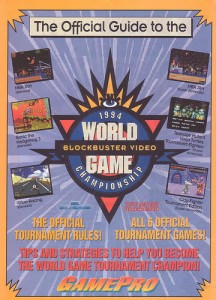
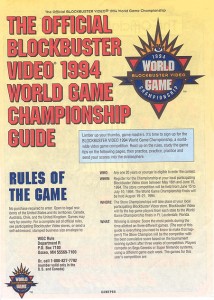
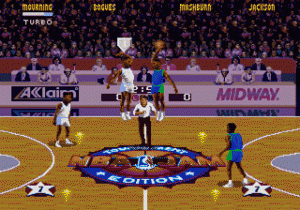
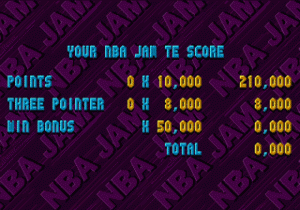
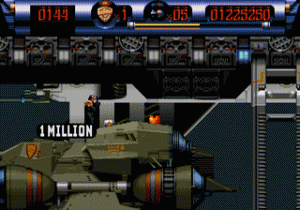
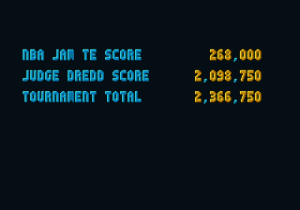
Pingback: Chris Hatala, Owner, GDL Entertainment: Member Spotlight Series @ ISES Cleveland
Just saw this game in a bundle of two segas sell for over 10K on shopgoodwilldotcom. here’s the page link. http://www.shopgoodwill.com/auctions/2-Sega-Genesis-Decks-2-Controllers-6-Games-14644562.html
Pingback: Blockbuster Dead For Good This Time